Events and excursions, Autumn 2016
ANNUAL LUNCHEON 2016
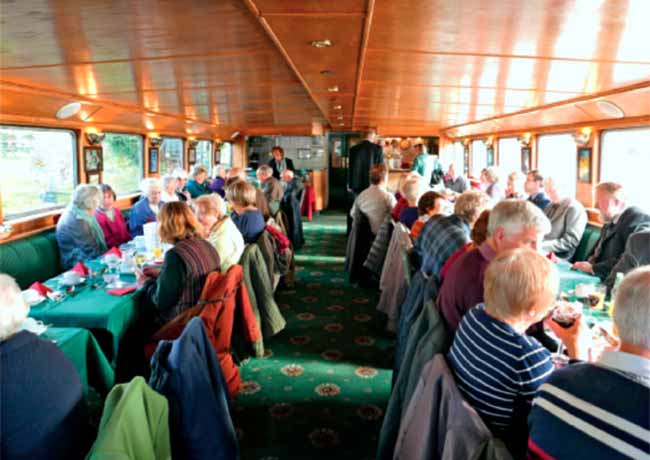
Intrepid Thorotonians await the serving of lunch on board the Princess Endeavour.
On 5th November (the day to remember) sixty-four members and friends enjoyed a day on the river - the river in question being, of course, “the smug and silver Trent”, and the day being fine and sunny as on our first such venture in 2009.

Flood marks under Trent Bridge (photograph courtesy of David Hoskins).
Our craft was the Princess Endeavour in which we cruised up river to Wilford and down river as far as Holme Pierrepont. As usual we were welcomed by our Chair, Professor John Beckett, and Alan Langton led our grace. We had a most agreeable lunch on board, served by the First Mate and his team, and, as we navigated the river, David Hoskins, late of the Environment Agency, gave us a commentary about the river and the places we were passing. We were intrigued by many of the buildings, bridges and other structures which David pointed out - some we hadn’t known about; others we were seeing from a new perspective. Up river we viewed St Wilfrid’s Church, Wilford. The church has memorial windows dedicated to the Nottingham poet Henry Kirke White. The gazebo in which Kirke-White wrote some of his poetry, and which is in the grounds of the Church, has been restored. We also saw the statue of Sir Robert Clifton by the Wilford Toll Bridge. The bridge has been widened and strengthened and now carries the Nottingham tram to Clifton.
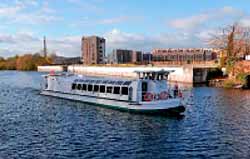
David described the Embankment and War Memorial, and the work carried out over the years to protect Nottingham from floods. The heights of many floods are recorded under Trent Bridge. Down river we saw Holme Sluices and Lock, and Holme Pierrepont Water Sports Centre, and caught a glimpse of St Edmund’s Church adjacent to Colwick Hall. And, of course, much more!
After lunch we raised our glasses for the toasts. John Beckett proposed that to the Queen and Richard Gaunt the toast to the Society. Our President, Adrian Henstock, responded to the toast with his thanks and gave a most interesting sketch of the river’s history.
The day was greatly enjoyed and the Chair, John Beckett, thanked David and Adrian for adding to the interest of the day, and also thanked the pilot and crew for looking after us so well.
More adventures on our lunch next year? Where will it be?
Barbara Cast, Honorary Secretary
LECTURE REPORT
Archaeology of the Nottingham Tram, Phase II by Dr Gareth Davies, Trent and Peak Archaeology, Saturday 8th October 2016
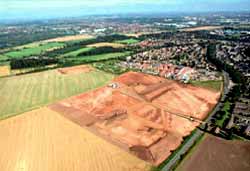
The Clifton site from the air with Nottingham in the distance.
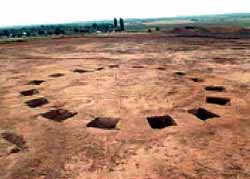
Bronze Age burial mound at Clifton.
The Thoroton Society has had, of course, a long association with archaeology and we are always pleased to hear of archaeological work going on in our city and county. Back in 1960, the Peveril Society, an active archaeological group, merged with Thoroton and, although active participation in digs is no longer a mainstream activity, we still keep a strong link with and interest in what is going on in the local archaeology world. This year and last, for example, we have arranged visits to view the work going on in Nottingham Castle precincts and will always welcome other opportunities for our members. Articles in Transactions demonstrate the strong commitment we have to ensure high-profile publication for archaeology reports.
On 8th October we received our Archaeology Lecture, given by Gareth Davies, Head of Operations at TPA, on the work done by its archaeologists during the installation of the second phase of the Nottingham tram.
Gareth informed us of the tremendous scope of the tram work with over 20 kms of track being laid, costing £560m plus. It was a great boost to Trent and Peak to win this important contract which was now in the post-excavation phase. The work undertaken by TPA revealed many interesting features and finds with several of the many watching briefs undertaken as the track bed was laid being followed up by excavation. Highlights of what was revealed included the marshy prehistoric landscape of University Boulevard. Environmental remains, including timber and peat, have been dated to the Late Neolithic, around 3000BC, showing that at that time the boulevard area was waterlogged. Within Beeston, some burials at St John’s church required excavation and subsequent appropriate reburial. One named individual was revealed - Mary Lowe aged 57 who was buried in 1882 and found to be suffering from scoliosis. Other finds included the remains of the Three Horseshoes pub and, in a tenement, a Napoleon III coin.
The main foci for extensive investigation were the Clifton terminus of the park and ride site and Lenton Priory. The 12 hectares of the Clifton site were stripped and investigated extensively. This was a prehistoric site, with a number of interesting features including a Bronze Age ring-ditch and a very large Late Neolithic or Early Bronze Age enclosure.
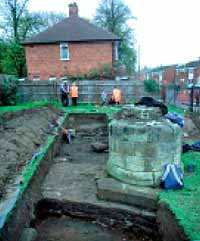
Work at Lenton Priory.
Lenton Priory was founded as a Cluniac monastery and a large excavation was carried out on its stratified remains. 12th century scalloped capitals, probably from the priory chapel, entrances to the transept, and an alphabet tile of the 1400s were among finds from this area. Also found associated with this site were Nottingham splash-ware, leather shoes in a waterlogged ditch, jetons (counters) of the 13th century, and many other articles which may well have been associated with the Martinmas Fair which was held for many generations in the outer precinct of the monastery - other finds and traces of where it was sited were also found. One notable discovery was a 14th century gold noble of Edward III - a sad loss for someone!
Thanks to Gareth for a fascinating insight into a major Winter excavation work at Lenton Priory piece of archaeological work in Nottingham. Look out for the forthcoming reports.
Barbara Cast
AUTUMN EXCURSION 2016
Leader’s report on the excursion to Clifton church and Sheffield Manor, Tuesday 20th September
Leader : Alan Langton
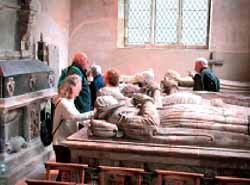
Our first stop on this excursion was at Saint Mary’s Church in Clifton village, a building which goes back to Domesday, and which has features which survived the Reformation. One is the cross which managed to avoid the iconoclasm of Reformation times, and the other is an incised altar slab which the villagers buried in the ground rather than see it smashed. One feature on the east side of the chancel arch was described by Pevsner as “the coat of arms of Christ surmounted by a spitting Jew, carved in low relief and painted, mid-15th century”. The shield is supposed to show the five wounds of Christ. The head looks as if it has two tongues, or perhaps it is intended to represent a snake-like forked tongue (see picture, page 10).
The connection between the church and the Clifton family goes back to at least 1272, and the north transept contains memorials to the family, carved in alabaster. The most striking feature of the interior, however, is the restoration work done in the eighties when Canon Wilf Wilkinson wished to make the church a centre of musical excellence. The project led to the acquisition of a new roof built for acoustics, a new Marcusson organ, and new pews and altar fittings which make for a delightful vison of the chancel and sanctuary. The main talk was given by Mrs Eileen Small, a member of the Society, with contributions from other members of the congregation, who had kindly come to provide coffee and refreshments for members.
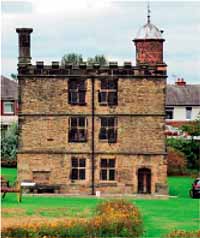
The journey up the M1 was trouble free, and we arrived at Sheffield Manor about midday where we were greeted by volunteers who work there. We were first given a talk about what the manor had possibly looked like originally, and then we were taken on a conducted tour of what remains of the manor after the various ravages of time and a lack of care in previous generations. David Templeman led the tour with well explained details about the history of the sections of the manor we were looking at, and especially of the time when Cardinal Wolsey and Mary Queen of Scots stayed there, Wolsey for eighteen days and Mary for fourteen years. David spoke in detail about how the manor had been originally, before the buildings were destroyed both by local developments and also by mining firms anxious to acquire coal and other minerals from the grounds. We were then entertained by an excellent performance by Barbara Ashton of an imaginary muttering of Bess of Hardwick as her responsibility for Mary Queen of Scots became more and more of a burden. After the tour we enjoyed a buffet lunch before our drive back to Nottingham. (David Templeman is currently writing a book about Sheffield Manor and Mary Queen of Scots, due to be published shortly).